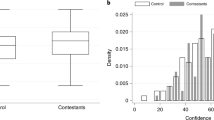Abstract
A Lie Detection Test—a videotape of senders delivering truthful and deceptive messages—was administered to subjects via one of three channels: Face only, speech only, or face plus speech. Feedback information, identifying the messages as truthful or deceptive, was given to some subjects (learning condition) but not to others (control). It was found that subjects in the learning condition performed better overall relative to control subjects, regardless of the channel presented to them. In addition, however, accuracy of subjects in the learning condition improved progressively over the course of the test (relative to control), for the speech only and face plus speech channels but not for the face only channel. This effect was interpreted in terms of the limited number of deception cues offered by the face.
Similar content being viewed by others
References
Ekman, P., & Friesen, W.V. Nonverbal leakage and cues to deception.Psychiatry, 1969,32, 88–106.
Ekman, P., & Friesen, W.V. Detecting deception from the body or face.Journal of Personality and Social Psychology, 1974,29, 288–298.
Rosenthal, R., & Rosnow, R.L.Essentials of behavioral research: Methods and data analysis. New York: McGraw-Hill, 1984.
Rosenthal, R., & Rubin, D.B. A single, general purpose display of magnitude of experimental effect.Journal of Educational Psychology, 1982,74, 166–169.
Zuckerman, M., Amidon, M.D., Bishop, S.E., & Pomerantz, S.D. Face and tone of voice in the communication of deception.Journal of Personality and Social psychology, 1982,43, 347–357.
Zuckerman, M., DePaulo, B.M., & Rosenthal, R. The verbal and nonverbal communication of deception. In L. Berkowitz (Ed.),Advances in experimental social psychology. Vol. 14. New York: Academic Press, 1981.
Zuckerman, M., Koestner, R., & Alton, A.O. Learning to detect deception.Journal of Personality and Social PSychology, 1984,46, 519–528.
Author information
Authors and Affiliations
Rights and permissions
About this article
Cite this article
Zuckerman, M., Koestner, R. & Colella, M.J. Learning to detect deception from three communication channels. J Nonverbal Behav 9, 188–194 (1985). https://doi.org/10.1007/BF01000739
Issue Date:
DOI: https://doi.org/10.1007/BF01000739




